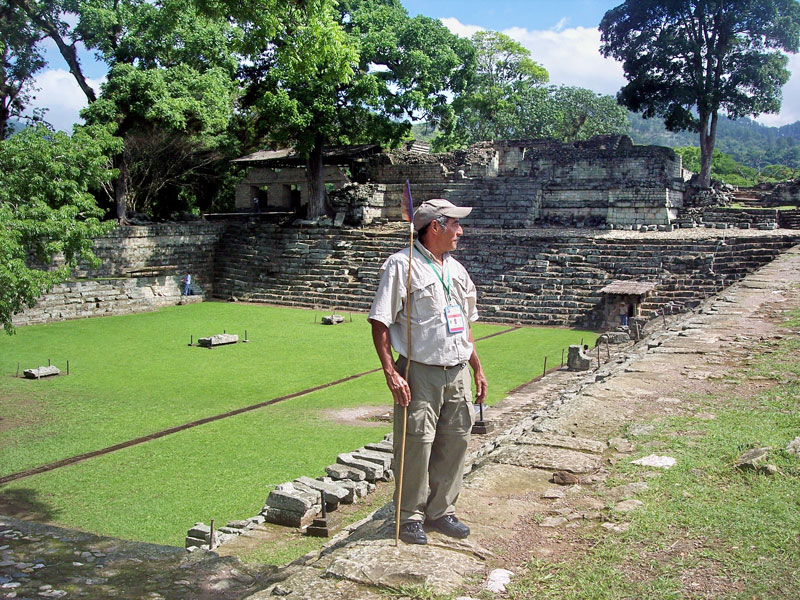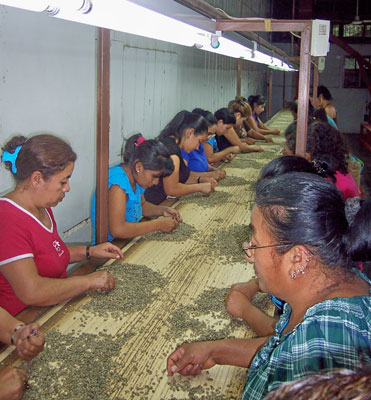El Salvador & Honduras Central American adventure
This item appears on page 63 of the September 2014 issue.
(Part 2 of 3)
El Salvador along with Copán in Honduras are the focus of the second part of my report on a June 2014, 4-country visit to Central America, a journey and itinerary partially hosted for me and operated by longtime ITN advertiser SITA World Tours (Encino, CA; 800/421-5643).
Upon my morning arrival in San Salvador by air from Managua, Nicaragua, I met my new guide, Suzy, and we immediately began an exploration of the hilly capital city, situated in the Salvador highlands. We drove first to the older part of the city and then — a dramatic contrast — the ultramodern newer section.
The city is surrounded by volcanoes and, historically, is prone to earthquakes. The cooler temperatures, due to the average elevation there being 2,100 feet, offered a welcome respite.
We visited the Devil’s Door lookout as well as a military museum with a huge, outdoor relief map of the country.
In a hillside residential neighborhood, I experienced papusa, a tasty local favorite that consists of two grilled tortillas filled with beans or meat and covered with pickled cabbage and a spicy tomato sauce.
With a population of about 567,700 (2,442,000 in the metro area), San Salvador is the fifth-most-populated city in Central America, and its metropolitan area is the second largest. A high percentage of its residents speak English, and there is greater diversity of religion than in other major Central American cities.
While it’s rarely an issue for visitors, San Salvador does have a problem with the type of neighborhood gang activity found in many North American cities. I, however, felt completely safe at all times during my visit.
The entire country of El Salvador has used the US dollar as its currency since 2001. It has proven to be a boon to the economy, with many foreign companies opening offices in San Salvador, their confidence based largely on the stable currency. The city certainly seems to be flourishing.
The coffee route
Despite the attractions of the city, I was looking forward to exploring the small towns and villages of the highlands on a day excursion, including part of what is referred to as the Ruta del Café, or Coffee Route.
My full-day tour included visits to two charming towns: Apaneca (elevation, 3,400 feet) and Concepción de Ataco (3,800 feet). In Ataco, we stopped at a thriving market and a hammock shop and, overlooking a tiny square, enjoyed a lunch of traditional highlands fare emphasizing local vegetables. The spring-like mountain temperatures were pure joy.
We then moved on to the amazing El Carmen Estate Hotel & Coffee Resort, at just over 4,000 feet in the western mountains. The coffee-processing facility has been in continuous operation since it was founded in 1930 and, incredibly, still uses the original machinery and processing system. On our guided tour of the facility, I was able to see the 85-year-old machines in operation — a real “wow” experience.
We visited the bean-sorting area and also witnessed workers each hauling coffee sacks weighing up to 150 pounds on their backs. It was a bit painful to watch, compounded by learning that each laborer’s salary is only about $180 per month. We ended the tour with a coffee-tasting session.
On our return to San Salvador, we were able to view Izalco Volcano, which erupted on a regular basis between the first overflow in 1770 and its final eruption in 1958.
Copán Ruinas
In the early afternoon of the following day, I departed by van with my driver for the 6-hour transfer north across the border into Honduras and on to the town of Copán Ruinas, near the famous pre-Columbian ruins.
At the Honduras border entry station, one of the senior officials asked us to give him a ride home, as it was the end of his shift and we were headed in the right direction. We were happy to comply, and he rode with us over 50 miles as we came to realize the reality of his daily commute to work by local bus.
Our transfer journey actually took eight hours and involved four challenging border crossings, since we had to pass through Guatemala before finally arriving, after dark, at our destination, the beautiful Clarion Hotel Copan Ruinas.
The following day, I learned that a new airport is scheduled to open soon near Copán Ruinas. Hopefully, it will render such arduous road transfers obsolete for most international visitors.
With a late-evening arrival in town and an early-afternoon departure to Guatemala the following day, my time there, unhappily, was far too limited. If you arrive in the evening, I absolutely recommend spending an extra day in Copán Ruinas to have time to explore the attractive cobblestone-street town and other area attractions.
The Clarion featured large rooms, an inviting pool, a spa and a wonderful restaurant with a relaxing outdoor dining area, where, surrounded by nature’s greenery, I was able to enjoy an excellent made-to-order breakfast.
The Copán ruins
Copán was one of the premier centers of Mayan civilization over a thousand years ago. Featuring more preserved sculpture than any other pre-Columbian city, the ruins are valued for the carved stelae of ancient rulers and remarkably well-preserved hieroglyphics.
The entry fee at the magnificent Copán ruins is $15, and I advise beginning your touring precisely at 8 a.m., when the doors open, as the heat/humidity index can kick up dramatically by mid-morning. Such was the case as I toured the site for 2½ hours with the park’s oldest registered guide, 71-year-old Fidel, a model of relaxed senior fitness.
Fidel advised me that his secret to good health is avoiding alcohol, getting lots of exercise daily, having a diet based on homegrown fresh vegetables and fruit, and leading a family-centered low-stress lifestyle. Is that all it takes?
In the archaeological park, there is a fine Mayan museum (entry, $7) that contains many impressive artifacts and a reconstructed temple. I recommend a visit.
To get the most out of your touring of the ruins, I recommend using one of the registered park guides. For most visitors, the entire site can be covered in some detail in three to four hours. Those highly interested in Mayan art and ancient ruins might spend up to two days on site. To be sure, photo opportunities abound at the Copán ruins.
Worth a quick visit, there are also some ruins a short walk uphill from the Clarion Hotel, and I would recommend seeing them if you’re staying at the property.
On to Guatemala
In the third and last part of this article about my adventure in Central America, I describe heading north to Guatemala and the popular colonial city of Antigua.
Beyond the Garden Wall
❝Trying to experience as much as possible in less-than-enough time versus experiencing less but with enough time to savor,
such has always been and is destined to be the dilemma for those who choose the path of the traveler ❞
— Randy’s pondering of his fast-paced Central America travel experience



